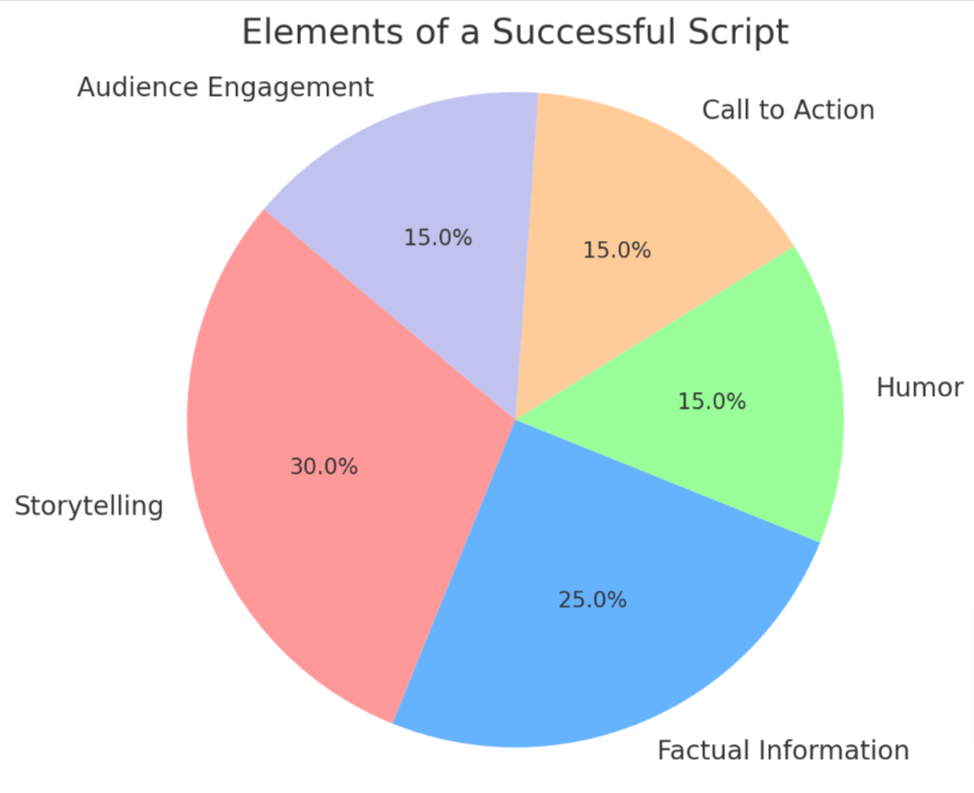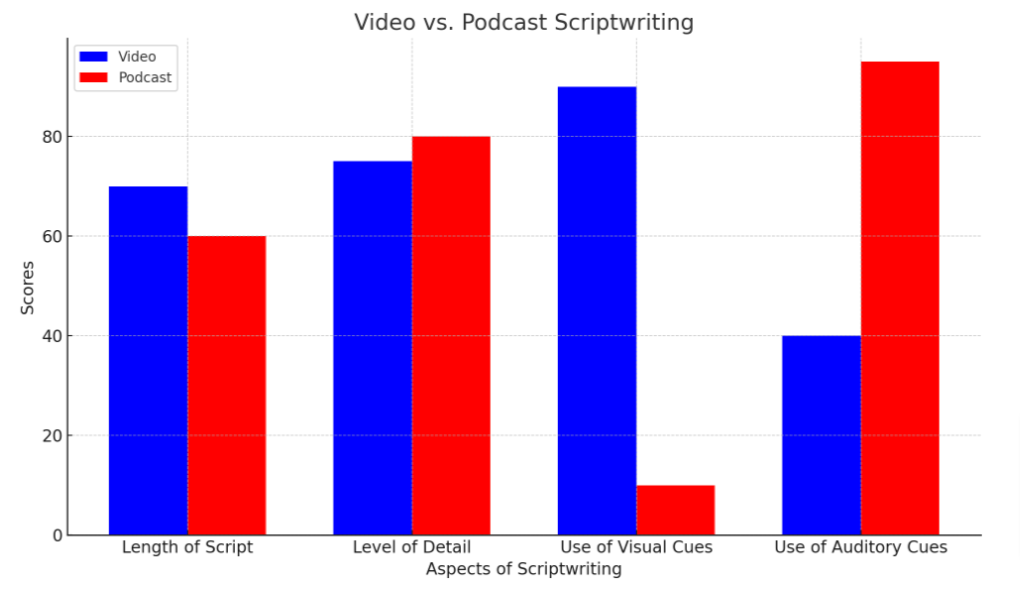Perfecting Script Writing Skills for Video and Podcast Success
Crafting the perfect words can feel like a puzzle in videos and podcasts. A well-written script is the secret behind engaging audiovisual content that captivates audiences. My article will guide you through crafting scripts that turn your ideas into stories, keeping listeners hooked from start to finish.
Dive in for success!
Key Takeaways
- Script writing provides structure and flow to videos and podcasts, ensuring that the content is clear, engaging, and maintains accuracy.
- Elements of a successful script include strong introductions, effective sponsor messages, smooth transitions, guest introductions with relevant background information, and compelling calls to action in the outro.
- Keeping the script conversational makes it relatable to viewers or listeners; using delivery notes guides performance; allowing improvisation adds authenticity; setting scenes helps audience immersion; maintaining a steady pace keeps attention focused.
- When scripting for videos specifically, it’s crucial to identify the video’s goal upfront and frame the content with context while employing transitions that emphasize key points without jarring shifts in topic or tone.
- For both videos and podcasts, engagement is enhanced by delivering content thoughtfully through careful planning of each segment and balancing information delivery with entertainment value.
The Importance of Script Writing for Videos and Podcasts
Script writing for videos and podcasts is crucial for providing structure, accuracy, and engagement. It ensures that content flows smoothly and keeps the audience captivated throughout the entire episode or video.
Provides structure and flow
Having a script for your video or podcast is like having a map on a long road trip. It guides you from start to finish, making sure all your points connect smoothly and logically. This structure keeps your message clear and prevents you from getting lost in tangents or forgetting crucial information.
A well-crafted script ensures that each segment flows into the next seamlessly, creating an enjoyable experience for listeners and viewers. With proper flow, transitions between topics become natural rather than abrupt, keeping the audience’s attention focused on your content without confusion or distraction.
Ensures accurate information
After establishing a solid structure and flow, script writing for videos and podcasts becomes pivotal in guaranteeing the accuracy of the information presented. A well-crafted script acts as a blueprint, ensuring that every fact and figure mentioned is double-checked and verified.
This attention to detail prevents the spread of misinformation, which is crucial in building trust with your audience. As podcast episode structure becomes increasingly complex, maintaining correctness of content throughout episodes protects both the creator’s credibility and satisfies listeners’ expectations for reliable content.
Script preparation also involves thorough research, which filters out errors before recording begins. By meticulously planning each segment – from introduction to sponsor messages to outro – writers cement factual integrity within their narrative creation process.
Scripts function not just as guidelines but as records of what has been scrutinized for precision; this means every story told, every piece of data cited aligns with reality. For video production or podcasting, where visuals or audio leave lasting impressions, sticking to accurate scripts ensures that your message remains clear without misleading viewers or listeners.
Keeps the audience engaged
Crafting a script that keeps the audience engaged is all about creating content that resonates and holds their interest from start to finish. Whether for podcast episode structure or video production, the narrative should unfold in a way that makes listeners and viewers feel invested in what’s coming next.
Using dynamic language, varying your tone, and incorporating storytelling elements ensures your script captivates and retains attention throughout.
Effective engagement also involves writing dialogue for podcasts or on-screen moments that spark curiosity or emotional responses. By introducing unexpected twists or compelling facts, you entice the audience to stay tuned.
It’s crucial to design each segment of your script with purposeful pacing—balancing information delivery with entertainment value—to keep boredom at bay and listeners eager for more.
Elements of a Successful Podcast Script
Successful podcast scripts include a well-crafted introduction, seamless guest introductions, effective delivery of sponsor messages, smooth transition segments, and a compelling outro with a clear call to action.
These elements are essential for creating engaging and impactful podcast episodes.
Introduction
When writing scripts for videos and podcasts, it is essential to ensure that the content flows smoothly and effectively engages the audience. The script provides a structure that guides the delivery of accurate information while maintaining engagement throughout.
By incorporating elements like introductions, transitions, and calls to action in podcast scripts or providing context, conversational tone, and key point highlights in video scripts, creators can captivate their audience and deliver compelling narratives.
With these best practices in mind, crafting engaging and purposeful scripts for audiovisual content becomes an achievable goal for content creators seeking to make an impact with their storytelling.
Guest Introduction
Introduce your guest with enthusiasm and relevant background information to captivate your audience from the start. Highlight their expertise or personal journey, setting the stage for an engaging and insightful conversation.
Use the introduction to establish a connection between the guest and your audience, creating anticipation for what’s to come in the podcast episode. Engage your listeners by sharing compelling details about the guest’s work or achievements, drawing them into the upcoming discussion.
Establish rapport with your guest during the introduction by acknowledging their accomplishments and expressing gratitude for their participation. Express genuine interest in their perspective, making them feel valued and welcome on your podcast.
Sponsor Messages
Include your sponsor messages strategically within your podcast or video script to ensure that they seamlessly integrate with the content. Craft these messages to align with your overall tone and keep them concise yet impactful, so they resonate with your audience.
Additionally, make sure to mention any special offers or promotions in a natural and non-disruptive manner, ensuring a smooth transition back into the main content.
Utilize delivery notes for the sponsor segments to maintain an engaging and conversational tone throughout these sections. This will help avoid sounding too scripted while still effectively delivering the intended promotional message.
Transition Segments
Transition segments play a crucial role in both podcasts and videos, helping to smoothly guide the audience from one topic to another. These short segments act as bridges between different parts of the content, providing an opportunity for hosts or presenters to change focus or introduce new ideas.
By utilizing transition segments effectively, creators can maintain a seamless flow throughout their podcast episodes or video productions, keeping listeners and viewers engaged at all times.
Incorporating smooth transitions between topics also allows for a more coherent narrative structure, enhancing the overall listening or viewing experience.
Outro and Call to Action
After wrapping up the key content of your podcast or video, it’s time to create a strong outro and call to action (CTA) that leaves a lasting impression on your audience. The outro should smoothly transition from the main content, leaving room for reflection while building anticipation for what’s next.
Incorporate a compelling CTA that encourages your viewers or listeners to engage further with your brand, whether it’s visiting your website, subscribing to your channel, or sharing their thoughts on social media.
A well-crafted outro and persuasive CTA can significantly impact audience retention and drive desired actions.

Tips for Writing a Great Podcast Script
Keep your podcast script conversational to engage your audience, use delivery notes to guide your performance, and allow for improvisation to keep the conversation natural. Set the scene for each segment and maintain a reasonable pace throughout the episode.
Be conversational
Incorporate a conversational tone into your podcast or video script to connect with your audience. Use language that feels natural and relatable, as if you’re having a conversation with a friend.
This helps in engaging the audience and creates a more immersive experience for them. By keeping the language conversational, you can hold the attention of your listeners or viewers throughout the entire episode or video, making it more enjoyable and impactful on them.
When writing scripts for videos or podcasts, ensure that each line flows smoothly and sounds authentic when spoken aloud. It’s essential to maintain an approachable tone that resonates with your target audience.
Use delivery notes
Incorporate delivery notes to enhance your podcast or video script. Include cues for tone, pacing, and emphasis to guide the delivery of content. By including these notes, you ensure that the intended message is conveyed effectively and with the right emotional impact.
These can also help maintain a conversational tone and engage your audience more naturally.
Crafting a successful script involves considering not just what is said but how it’s delivered. Utilizing delivery notes can make all the difference in creating an engaging and impactful audio or visual production.
– Allow for improvisation when needed
Allow for improvisation
When writing a podcast or video script, allowing for improvisation can add authenticity and spontaneity to your content. This flexibility allows hosts and guests to naturally respond to each other’s comments, enhancing the conversational flow of the episode.
By leaving space for improvisation, you also create opportunities for unexpected moments of humor or insight that can captivate your audience and make the content more relatable.
Embracing improvisation in your scripts helps in creating an atmosphere where genuine interactions can shine through, keeping your audience engaged and interested in what you have to say.
As you integrate this element into your scriptwriting process, remember that it’s essential to strike a balance between structure and spontaneity for compelling audio or visual content.
Set the scene
Encourage the audience to visualize the setting or context. Describe the surroundings and atmosphere, creating a sense of place for your narrative without overwhelming with detail or unnecessary information.
Engage the senses by highlighting sounds, smells, and key visual elements that will draw the audience into your story. This approach captures attention and sets a strong foundation for delivering impactful content.
Craft an immersive experience through descriptive language. Establishing this scene allows you to effectively convey your message while evoking emotions and capturing listeners’ interest early on in your podcast or video.
Maintain a reasonable pace
Once you’ve set the scene for your video or podcast, it’s crucial to maintain a reasonable pace throughout. This ensures that your audience stays engaged and can easily follow along with the content.
Keeping a steady tempo allows for effective delivery of information and helps to build anticipation for what comes next in the script. By maintaining a reasonable pace, you can better control the flow of your narrative and keep your listeners or viewers captivated.
Crafting an engaging script involves more than just words on paper; it requires attention to pacing to create a compelling listening or viewing experience. Whether you’re scripting a podcast episode or a video production, maintaining a consistent rhythm will help you connect with your audience and hold their interest from start to finish.
How to Write a Video Script
When writing a video script, it’s important to determine your goal and provide context, while maintaining a conversational tone and using transitions to highlight key points. This will help you create engaging content that resonates with your audience.
Determine your goal
Identify the purpose of your video before you start scripting. Consider whether it’s intended to inform, entertain, or persuade. Having a clear goal will guide the scriptwriting process and help maintain a coherent narrative.
Consider audience engagement when setting your objectives. Determine what action you want viewers to take after watching the video, whether it’s subscribing to a channel, sharing the content, or visiting a website.
By aligning your goals with audience interest and behavior, you can create an effective and impactful script that resonates with viewers.
Provide context
When writing a podcast or video script, it’s essential to provide context. This means clearly outlining the purpose and setting the scene for your content. By establishing the context early on, you help the audience understand what to expect and why they should engage with your material.
In a podcast script, this could involve introducing the topic and explaining its relevance, while in a video script, it might mean visually depicting the setting or situation to frame the narrative.
By providing context at the outset of your script, you lay a solid foundation for an engaging and coherent piece of content that resonates with your audience’s interests. This approach sets the stage for effective storytelling and ensures that viewers or listeners are fully immersed in the experience from start to finish.
Write in a conversational tone
Ready to dive into the world of script writing for videos and podcasts? Whether you’re creating a captivating podcast episode or an engaging video, scriptwriting is essential. It provides structure and keeps your content flowing smoothly, ensuring your audience stays hooked from start to finish.
Plus, using conversational language in your scripts helps maintain a casual tone that resonates with listeners and viewers, making your content more relatable. Don’t forget to include those key points; it’s what keeps your audience engaged throughout!
Use transitions
To achieve a seamless flow in your podcast or video script, it is essential to strategically incorporate transitions. Transitions help move from one idea to the next smoothly, guiding the audience through the content.
By utilizing transition phrases such as “in addition,” “furthermore,” or “on the other hand,” you can effectively connect different segments of your script and maintain audience engagement.
Including transitions also creates cohesion between thoughts and ideas, allowing for a more coherent and understandable narrative throughout your video or podcast.
Highlight key points
When writing a video script, it’s important to determine your goal and provide contextual information. Additionally, write in a conversational tone to engage your audience and use transitions to smoothly guide them through the content.
Remember to highlight key points to keep the audience focused and interested.
For podcast scripts, make sure to include an introduction, guest introductions, sponsor messages, transition segments, and an outro with a call to action. Use storytelling techniques for audio content creation and narrative development.
Consider using delivery notes for pacing and allowing room for improvisation while maintaining structure.

Conclusion
In conclusion, script writing for videos and podcasts plays a crucial role in providing structure and maintaining audience engagement. Crafting successful podcast scripts involves elements such as introductions, sponsor messages, and transition segments.
When writing a video script, it’s important to determine the goal and write in a conversational tone while highlighting key points. Incorporating these tips can help create compelling content that resonates with your audience.

